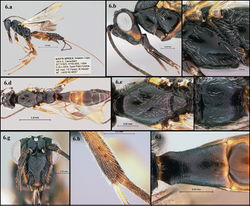Camptothlipsis inertusursus
| Notice: | This page is derived from the original publication listed below, whose author(s) should always be credited. Further contributors may edit and improve the content of this page and, consequently, need to be credited as well (see page history). Any assessment of factual correctness requires a careful review of the original article as well as of subsequent contributions.
If you are uncertain whether your planned contribution is correct or not, we suggest that you use the associated discussion page instead of editing the page directly. This page should be cited as follows (rationale):
Citation formats to copy and paste
BibTeX: @article{Tucker2012JournalofHymenopteraResearch24, RIS/ Endnote: TY - JOUR Wikipedia/ Citizendium: <ref name="Tucker2012Journal of Hymenoptera Research24">{{Citation See also the citation download page at the journal. |
Ordo: Hymenoptera
Familia: Braconidae
Genus: Camptothlipsis
Name
Camptothlipsis inertusursus Tucker & Sharkey sp. n. – Wikispecies link – ZooBank link – Pensoft Profile
Diagnosis
This species is distinguished by its short malar space, smooth notauli, smooth or almost smooth sternaulus, weak propodeal sculpture, and mostly black coloration (Figs 6.a – 6.i).
Description
Holotype female; length: 3.6mm (3.5–4.5mm).
Head (Figs 6.b, 6.g) – 22 (22–27) flagellomeres; malar length shorter than eye height (0.26 vs. 3.6mm); glossa longer than head height (0.80 vs. 0.70mm); anterior face about as wide as high; ventral-most anterior edge of face about same length as greatest interantennal space; lightly covered with pale setae.
Mesosoma (Figs 6.c, 6.e, 6.f) - Median mesonotal lobe smooth; notauli smooth, ending posteriorly where joined medially; scutellar sulcus partitioned into 7 (5–8) sections by longitudinal carinae; metanotum weakly to very weakly pitted; propodeum very weakly rugose, often appearing almost smooth, with a weak anteromedial carina; sternaulus about ¾ length of mesopleuron, smooth to very weakly foveolate; metapleuron mostly smooth with some weak rugosity around the ventral edges, moderately covered with pale setae.
Metasoma (Fig. 6.i) - First median tergite longer than wide (0.45 vs. 0.34mm), apical width slightly less than 2× basal width, sculpture granulate; ovipositor slightly longer than mesosoma + metasoma.
Legs (Fig. 6.h) - Mid leg with 3 (3–5) apical and 2 (2–3) subapical spines; hind femur length about 3x as long as wide, hind tibia with 10 (6–12) apical spines (occasionally 1 subapical spine), entire leg covered with pale setae.
Color - Black except yellow to orange as follows: longitudinal band on malar space, apex of antennal pedicel, base of first flagellomere, labrum, mandible, tegula, legs, 2nd and 3rd metasomal terga and ovipositor, coxa brown-black; wings translucent with brown to light brown veins.
Etymology
From the Latin inertus (lazy), and ursus (bear). The species is named for the first author’s father, whom she thought would be amused by the name.
GenBank accession numbers
JN564490; JN564491; JN564492; JN565593.
Material Examined
HOLOTYPE: female, South Africa: Western Cape, 10km S. Clanwilliam, 32°13.39'S, 18°50.50'E, 140m, 5–25.X.2004, sand plain fynbos, ME Irwin, FD Parker, M Hauser, MT, LW02-N2-M207 (SAMC). PARATYPES: 2 females, same locality and date data as holotype (HIC and SAMC) (accession number JN565593).
Original Description
- Tucker, E; Sharkey, M; Stoelb, S; 2012: A new species-group of Camptothlipsis (Braconidae, Agathidinae) from South Africa, with notes on the evolution of long mouthparts Journal of Hymenoptera Research, 24: 59-74. doi
Images
|
